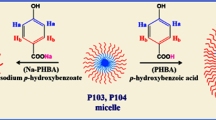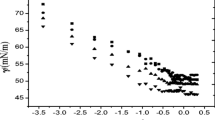Abstract
The results on changes in the apparent hydrodynamic diameter (Dh) of micelles in a solution containing 5% of a moderately hydrophobic/hydrophilic triblock PEO-PPO-PEO copolymer in the presence of several hydroxyl compounds at 23 °C from dynamic light scattering (DLS) are reported. Distribution plots show micelles with hydrodynamic diameter ~17 nm and low polydispersity (<0.1) except at low concentrations where a unimer peak (~ 4 nm) was also noticed. These additives increase/decrease the micelle size and show micellar transition depending upon their hydrophilicity/hydrophobicity. The results are discussed in terms of the effect of the additives on altering water structure and their partitioning in micelle. Short chain alcohols (C1–C3) increase solvation of PEO and thus increase micelle hydrodynamic size while higher alcohols, initially reduce Dh due shrinkage of PEO followed by micellar growth at higher concentrations. Among αω-alkanediols, C2 and C4 diols increase micelle size by immobilizing water sphere around the micelles whereas higher diols form wicket like structures and reside in palisade layer. Isomeric hexanediols (1,2; 1,5; 2,5 and 1,6) alter micelle size in different ways depending on their hydrophobicity. In C6EO m (m = 0, 1, 2), as the number of EO group increases, it becomes more hydrophilic and increases Dh at higher concentration. Addition of a hydrophobic triblock copolymer leads to unfavorable mixing with a moderately hydrophobic/hydrophilic triblock copolymer which results in increase in size, while the addition of a hydrophilic counterpart increases the average hydrodynamic size and follows appearance of unimer peak.








Similar content being viewed by others
References
Batrakova EV, Kabanov AV (2008) Pluronic block copolymers: evolution of drug delivery concept from inert nanocarriers to biological response modifiers. J Control Release 130:98–106
Alexandridis P, Hatton TA (1995) Poly(ethylene oxide)-poly(propylene oxide)-poly(ethylene oxide) block copolymer surfactants in aqueous solutions and at interfaces: thermodynamics, structure, dynamics, and modeling. Colloids Surf A 96:1–46
Nakashima K, Bahadur P (2006) Aggregation of water-soluble block copolymers in aqueous solutions: recent trends. Adv Colloid Interface Sci 123:75–96
Alfredsson V, Amenitsch H, Kleitz F, Lindén M, Linton P, Teixeira CV (2005) Formation mechanism of mesoporous silica formed with triblock copolymers: effect of salt addition. Stud Surf Sci Catal 158:97–104
ImpérorClerc M, Manet S, Grillo I, Durand D, Khodakov A, Zholobenko V (2008) SANS study of the mechanisms and kinetics of the synthesis of mesoporous materials from micelles of tri-block copolymers. Stud Surf Sci Catal 174:805–810
Rahme K, Oberdisse J, Schweins R, Gaillard C, Marty JD, Mingotaud C, Gauffre F (2008) Pluronics-stabilized gold nanoparticles: investigation of structure of polymer-particle hybrid. Chem Phys Chem 9:2230–2236
Bakshi MS, Kaura A, Bhandari P, Kaur G, Torigoe K, Esumi K (2006) Synthesis of colloidal gold nanoparticles of different morphologies in the presence of triblock polymer micelles. J Nanosci Nanotechnol 6:1405–1410
Zhao D, Feng J, Huo Q, Melosh N, Fredrickson GH, Chmelka BF, Stucky GD (1998) Triblock copolymer syntheses of mesoporous silica with periodic 50 to 300 Angstrom pores. Science 279:548
Shaheen A, Kaur N, Mahajan RK (2008) Influence of various series of additives on the clouding behavior of aqueous solutions of triblock copolymers. Colloid Polym Sci 286:319–325
Bharatiya B, Guo C, Ma JH, Hassan PA, Bahadur P (2007) Aggregation and clouding behavior of aqueous solution of EO–PO block copolymer in presence of n-alkanols. Eur Poly J 43:1883–1891
Kadam Y, Bharatiya B, Hassan PA, Verma G, Aswal VK, Bahadur P (2010) Effect of an amphiphilic diol (Surfynol®) on the micellar characteristics of PEO–PPO–PEO block copolymers in aqueous solutions. Colloid Surf A 363:110–118
Mata JP, Majhi PR, Kubota O, Khanal A, Nakashima K, Bahadur P (2008) Effect of phenol on the aggregation characteristics of an ethylene oxide–propylene oxide triblock copolymer P65 in aqueous solution. J Colloid Interf Sci 320:275–282
Mahajan RK, Vohra KK, Kaur N, Aswal VK (2008) Organic additives and electrolytes as cloud point modifiers in octylphenol ethoxylate solutions. J Surfact Deterg 11:243–250
Sharma KS, Patil SR, Rakshit AK (2003) Study of the cloud point of C12E n nonionic surfactants: effect of additives. Colloids Surf A 219:67–74
Bommel AV, Palepu RM (2004) n-Alkanol induced clouding of Brij® 56 and the energetics of the process. Colloids Surf A 233:109–115
Liang X, Guo C, Ma JH, Wang J, Chen S, Liu H (2007) Temperature-dependent aggregation and disaggregation of poly(ethylene oxide)-poly(propylene oxide)-poly(ethylene oxide) block copolymer in aqueous solution. J Phys Chem B 111:13217–13220
Mata JP, Majhi PR, Guo C, Liu HZ, Bahadur P (2005) Concentration, temperature, and salt-induced micellization of a triblock copolymer Pluronic L64 in aqueous media. J Colloid Interf Sci 292:548–556
Bahadur P, Li P, Almgren M, Brown W (1992) Effect of potassium fluoride on the micellar behavior of Pluronic F-68 in aqueous solution. Langmuir 8:1903–1907
Álvarez-Ramírez JG, Fernández VVA, Macías ER, Rharbi Y, Taboada P, Gámez-Corrales R, Puig JE, Soltero JFA (2009) Phase behavior of the Pluronic P103/water system in the dilute and semi-dilute regimes. J Colloid Interf Sci 333:655–662
Lindner H, Scherf G, Glatter O (2003) Dynamic and static properties of the concentrated micellar solution and gel phase of a triblock copolymer in water. Phys Rev E 67:061402–061411
Bahadur P, Pandya K (1992) Aggregation behavior of Pluronic P-94 in water. Langmuir 8:2666–2670
Ganguly R, Aswal VK, Hassan PA, Gopalakrishnan IK, Yakhmi JV (2005) Sodium chloride and ethanol induced sphere to rod transition of triblock copolymer micelles. J Phys Chem B 109:5653–5658
Su Y, Wei XF, Liu HZ (2003) Influence of 1-pentanol on the micellization of poly(ethylene oxide)-poly(propylene oxide)-poly(ethylene oxide) block copolymers in aqueous solutions. Langmuir 19:2995–2999
Caragheorgheopol A, Caldararu H, Dragutan I, Joela H, Brown W (1997) Micellization and micellar structure of a poly(ethylene oxide)/poly(propylene oxide)/poly(ethylene oxide) triblock copolymer in water solution, as studied by the spin probe technique. Langmuir 13:6912–6921
Brown JC, Pusey PN, Dietz R (1975) Photon correlation study of polydisperse samples of polystyrene in cyclohexane. J Chem Phys 62:1136–1144
Garg G, Hassan PA, Kulshreshtha SK (2006) Dynamic light scattering studies of rod-like micelles in dilute and semi-dilute regime. Colloids Surf A 275:161–167
Brown W, Johansson K, Almgren M (1989) Threadlike micelles from cetyltrimethylammonium bromide in aqueous sodium naphthalene sulfonate solutions studied by static and dynamic light scattering. J Phys Chem 93:5888–5894
Amin S, Kermis TW, Zanten RMV, Dees SJ, Zanten JHV (2001) Concentration fluctuations in CTAB/NaSal solutions. Langmuir 17:8055–8061
Nemoto N, Yamamura T, Osaki K, Shikata T (1991) Diffusion of a dye-labeled cetyldimethylamine incorporated in rodlike micelles of cetyltrimethylammonium bromide in aqueous sodium salicylate solutions. Langmuir 7:2607–2613
Das C, Das B (2009) Thermodynamic and interfacial adsorption studies on the micellar solutions of alkyltrimethylammonium bromides in ethylene Glycol (1) + water (2) mixed solvent media. J Chem Eng Data 54:559–565
Ruiz CC (1999) Thermodynamics of micellization of tetradecyltrimethylammonium bromide in ethylene glycol ± water binary mixtures. Colloid Polym Sci 277:701–707
Mahajan RK, Chawla J, Bakshi MS (2004) Effects of monomeric and polymeric glycol additives on micellar properties of Tween non-ionic surfactants as studied by cyclic voltammetry. Colloids Surf A 237:119–124
Mullally MK, Doyle MJ, Marangoni DG (2004) The partitioning of alkanediols into SDS and DTAB micelles from NMR-PRE experiments. Colloid Polym Sci 283:335–339
Ishikawa M, Matsumura K-I, Esumi K, Meguro K, Binana-Limbale W, Zana R (1992) Aggregation behavior of α,ω-type nonionic surfactant in aqueous solution. J Colloid Interf Sci 151:70–78
Romero CM, Paez MS, Miranda JA, Hernandez DJ, Oviedo LE (2007) Effect of temperature on the surface tension of diluted aqueous solutions of 1,2-hexanediol, 1,5-hexanediol, 1,6-hexanediol and 2,5-hexanediol. Fluid Phase Equilibria 258:67–72
Szekely NK, Almasy L, Radulescu A, Rosta L (2007) Small-angle neutron scattering study of aqueous solutions of pentanediol and hexanediol. J Appl Cryst 40:307–311
Flynn DJ, Kutay SM, Hawrylak BE, Kennedy CA, Alexander EV, Howard JA, Marangoni DG (2002) Thermodynamics of micellization of ionic surfactant/alkoxyethanol mixed micelles as a function of temperature. Colloid Polym Sci 280:848–856
Marangoni DG, Kwak JCT (1991) Solubilization of alcohols and ethoxylated alcohols in anionic and cationic micelles. Langmuir 7:2083–2088
Bakshi MS (2000) Influence of alkoxyethanols on mixed micelle formation by hexadecyltrimethylammonium bromide surfactant mixture. Colloid Polym Sci 278:1155–1163
Bakshi MS, Bhandari P (2007) Fluorescence studies on the non-ideal mixing in triblock copolymer binary mixtures under the effect of temperature: a block hydration effect. J Photochem Photobio A: Chemistry 186:166–172
Alexandridis P, Holzwarth JF, Hatton TA (1994) Micellization of poly(ethy1eneoxide)-poly(propy1eneoxide)-poly(ethy1eneoxide) triblock copolymers in aqueous solutions: thermodynamics of copolymer association. Macromolecules 27:2414–2425
Acknowledgments
PB thanks Prof. G. Marangoni, StFx University, Antigonish, Canada for providing facilities for DLS measurements. PP thanks UGC, New Delhi for a fellowship under BSR scheme.
Author information
Authors and Affiliations
Corresponding author
About this article
Cite this article
Parekh, P., Bahadur, P. Dynamic Light Scattering Studies on the Effect of 1-Alkanols, Alkanediols and Alkoxyethanols on the Micelles of a Moderately Hydrophobic/Hydrophilic PEO-PPO-PEO Triblock Copolymer. J Surfact Deterg 14, 425–432 (2011). https://doi.org/10.1007/s11743-011-1247-6
Received:
Accepted:
Published:
Issue Date:
DOI: https://doi.org/10.1007/s11743-011-1247-6




